Leadership Theories, Personal Profile and Scenario Analysis Report
VerifiedAdded on 2022/08/14
|12
|2759
|18
Report
AI Summary
This report delves into various leadership concepts, including trait theory, situational leadership, transformational leadership, and servant leadership. It analyzes these theories, exploring personal leadership traits like loyalty, reliability, and decision-making abilities, while also acknowledging areas needing improvement, such as self-confidence. The report compares different leadership styles, favoring transformational leadership for its adaptability and focus on employee development. It identifies Nelson Mandela and Martin Winterkorn as examples of effective and ineffective leaders, respectively. A personal management profile is developed, emphasizing the adoption of transformational and situational leadership styles. Finally, the report analyzes leadership scenarios, recommending specific leadership approaches such as telling and directive path leadership to address employee performance issues and improve job satisfaction.

Leadership
Paraphrase This Document
Need a fresh take? Get an instant paraphrase of this document with our AI Paraphraser
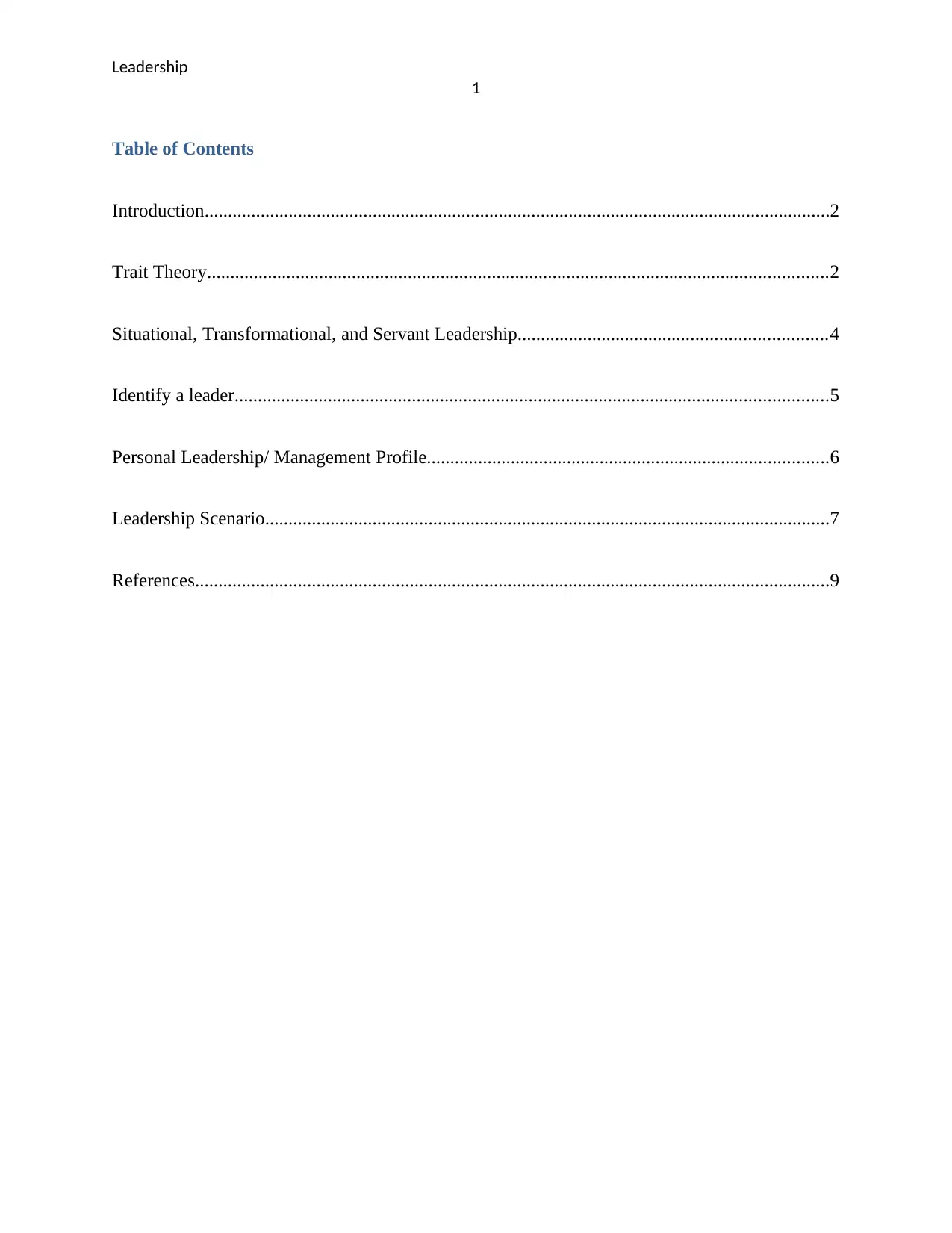
Leadership
1
Table of Contents
Introduction......................................................................................................................................2
Trait Theory.....................................................................................................................................2
Situational, Transformational, and Servant Leadership..................................................................4
Identify a leader...............................................................................................................................5
Personal Leadership/ Management Profile......................................................................................6
Leadership Scenario.........................................................................................................................7
References........................................................................................................................................9
1
Table of Contents
Introduction......................................................................................................................................2
Trait Theory.....................................................................................................................................2
Situational, Transformational, and Servant Leadership..................................................................4
Identify a leader...............................................................................................................................5
Personal Leadership/ Management Profile......................................................................................6
Leadership Scenario.........................................................................................................................7
References........................................................................................................................................9
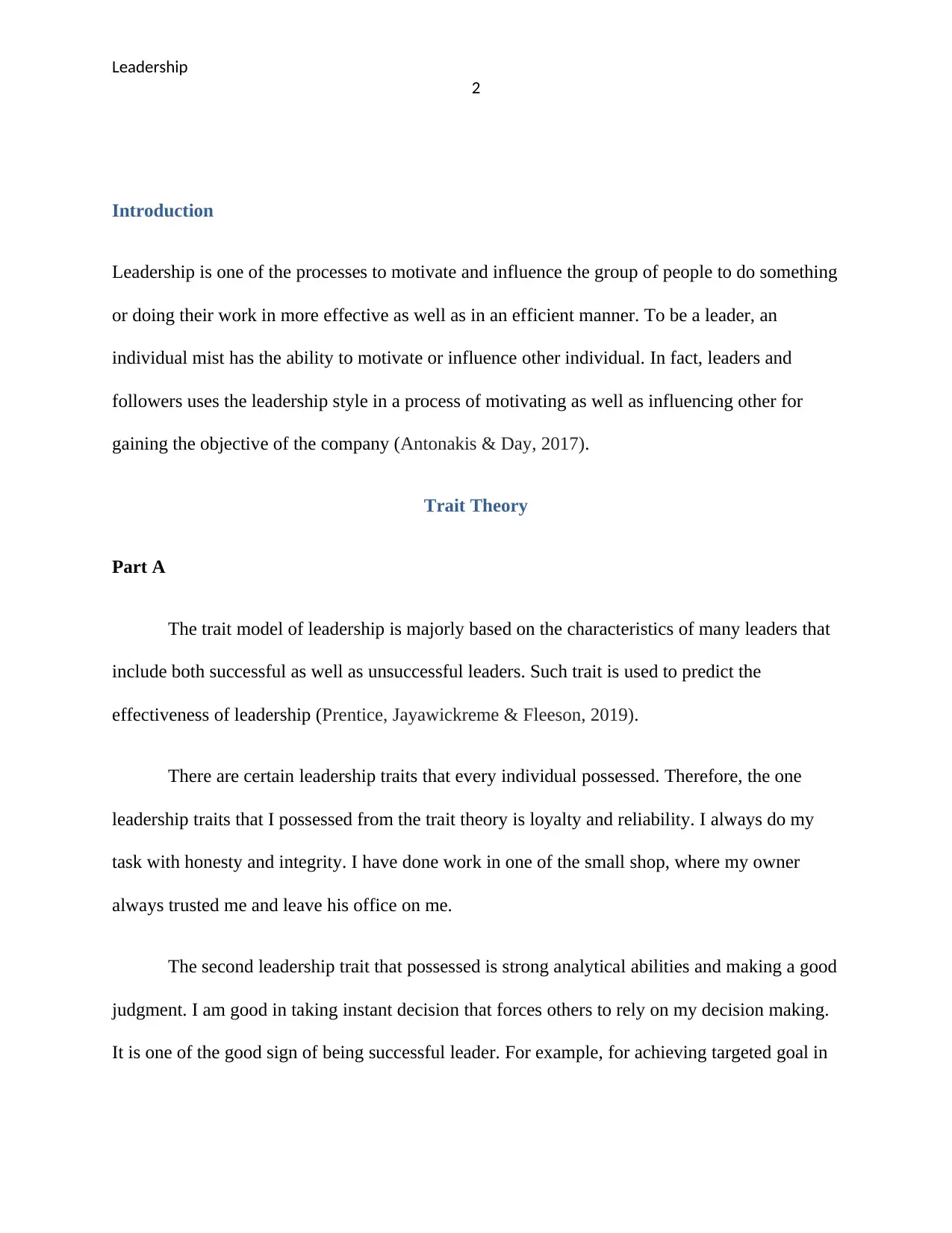
Leadership
2
Introduction
Leadership is one of the processes to motivate and influence the group of people to do something
or doing their work in more effective as well as in an efficient manner. To be a leader, an
individual mist has the ability to motivate or influence other individual. In fact, leaders and
followers uses the leadership style in a process of motivating as well as influencing other for
gaining the objective of the company (Antonakis & Day, 2017).
Trait Theory
Part A
The trait model of leadership is majorly based on the characteristics of many leaders that
include both successful as well as unsuccessful leaders. Such trait is used to predict the
effectiveness of leadership (Prentice, Jayawickreme & Fleeson, 2019).
There are certain leadership traits that every individual possessed. Therefore, the one
leadership traits that I possessed from the trait theory is loyalty and reliability. I always do my
task with honesty and integrity. I have done work in one of the small shop, where my owner
always trusted me and leave his office on me.
The second leadership trait that possessed is strong analytical abilities and making a good
judgment. I am good in taking instant decision that forces others to rely on my decision making.
It is one of the good sign of being successful leader. For example, for achieving targeted goal in
2
Introduction
Leadership is one of the processes to motivate and influence the group of people to do something
or doing their work in more effective as well as in an efficient manner. To be a leader, an
individual mist has the ability to motivate or influence other individual. In fact, leaders and
followers uses the leadership style in a process of motivating as well as influencing other for
gaining the objective of the company (Antonakis & Day, 2017).
Trait Theory
Part A
The trait model of leadership is majorly based on the characteristics of many leaders that
include both successful as well as unsuccessful leaders. Such trait is used to predict the
effectiveness of leadership (Prentice, Jayawickreme & Fleeson, 2019).
There are certain leadership traits that every individual possessed. Therefore, the one
leadership traits that I possessed from the trait theory is loyalty and reliability. I always do my
task with honesty and integrity. I have done work in one of the small shop, where my owner
always trusted me and leave his office on me.
The second leadership trait that possessed is strong analytical abilities and making a good
judgment. I am good in taking instant decision that forces others to rely on my decision making.
It is one of the good sign of being successful leader. For example, for achieving targeted goal in
⊘ This is a preview!⊘
Do you want full access?
Subscribe today to unlock all pages.

Trusted by 1+ million students worldwide
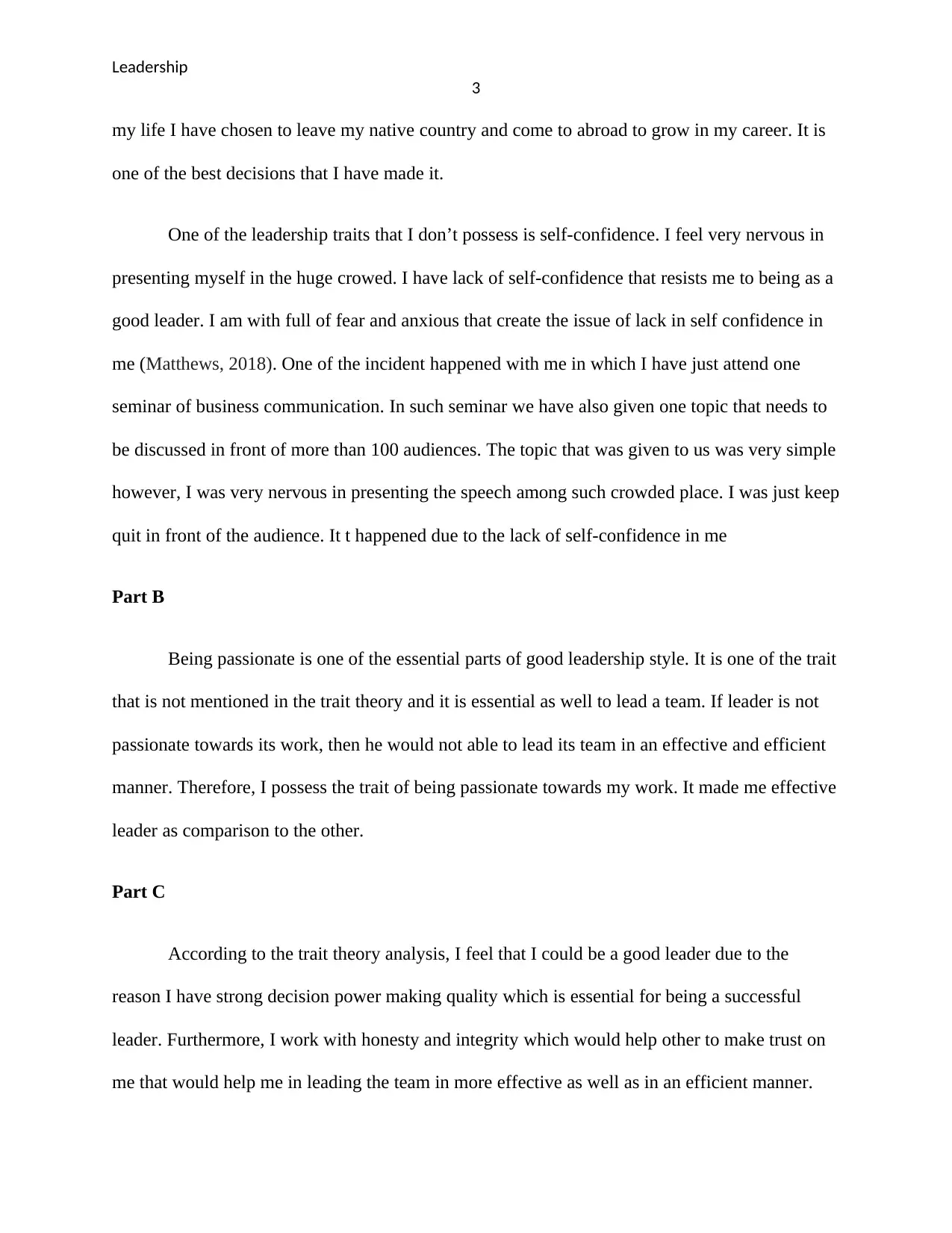
Leadership
3
my life I have chosen to leave my native country and come to abroad to grow in my career. It is
one of the best decisions that I have made it.
One of the leadership traits that I don’t possess is self-confidence. I feel very nervous in
presenting myself in the huge crowed. I have lack of self-confidence that resists me to being as a
good leader. I am with full of fear and anxious that create the issue of lack in self confidence in
me (Matthews, 2018). One of the incident happened with me in which I have just attend one
seminar of business communication. In such seminar we have also given one topic that needs to
be discussed in front of more than 100 audiences. The topic that was given to us was very simple
however, I was very nervous in presenting the speech among such crowded place. I was just keep
quit in front of the audience. It t happened due to the lack of self-confidence in me
Part B
Being passionate is one of the essential parts of good leadership style. It is one of the trait
that is not mentioned in the trait theory and it is essential as well to lead a team. If leader is not
passionate towards its work, then he would not able to lead its team in an effective and efficient
manner. Therefore, I possess the trait of being passionate towards my work. It made me effective
leader as comparison to the other.
Part C
According to the trait theory analysis, I feel that I could be a good leader due to the
reason I have strong decision power making quality which is essential for being a successful
leader. Furthermore, I work with honesty and integrity which would help other to make trust on
me that would help me in leading the team in more effective as well as in an efficient manner.
3
my life I have chosen to leave my native country and come to abroad to grow in my career. It is
one of the best decisions that I have made it.
One of the leadership traits that I don’t possess is self-confidence. I feel very nervous in
presenting myself in the huge crowed. I have lack of self-confidence that resists me to being as a
good leader. I am with full of fear and anxious that create the issue of lack in self confidence in
me (Matthews, 2018). One of the incident happened with me in which I have just attend one
seminar of business communication. In such seminar we have also given one topic that needs to
be discussed in front of more than 100 audiences. The topic that was given to us was very simple
however, I was very nervous in presenting the speech among such crowded place. I was just keep
quit in front of the audience. It t happened due to the lack of self-confidence in me
Part B
Being passionate is one of the essential parts of good leadership style. It is one of the trait
that is not mentioned in the trait theory and it is essential as well to lead a team. If leader is not
passionate towards its work, then he would not able to lead its team in an effective and efficient
manner. Therefore, I possess the trait of being passionate towards my work. It made me effective
leader as comparison to the other.
Part C
According to the trait theory analysis, I feel that I could be a good leader due to the
reason I have strong decision power making quality which is essential for being a successful
leader. Furthermore, I work with honesty and integrity which would help other to make trust on
me that would help me in leading the team in more effective as well as in an efficient manner.
Paraphrase This Document
Need a fresh take? Get an instant paraphrase of this document with our AI Paraphraser
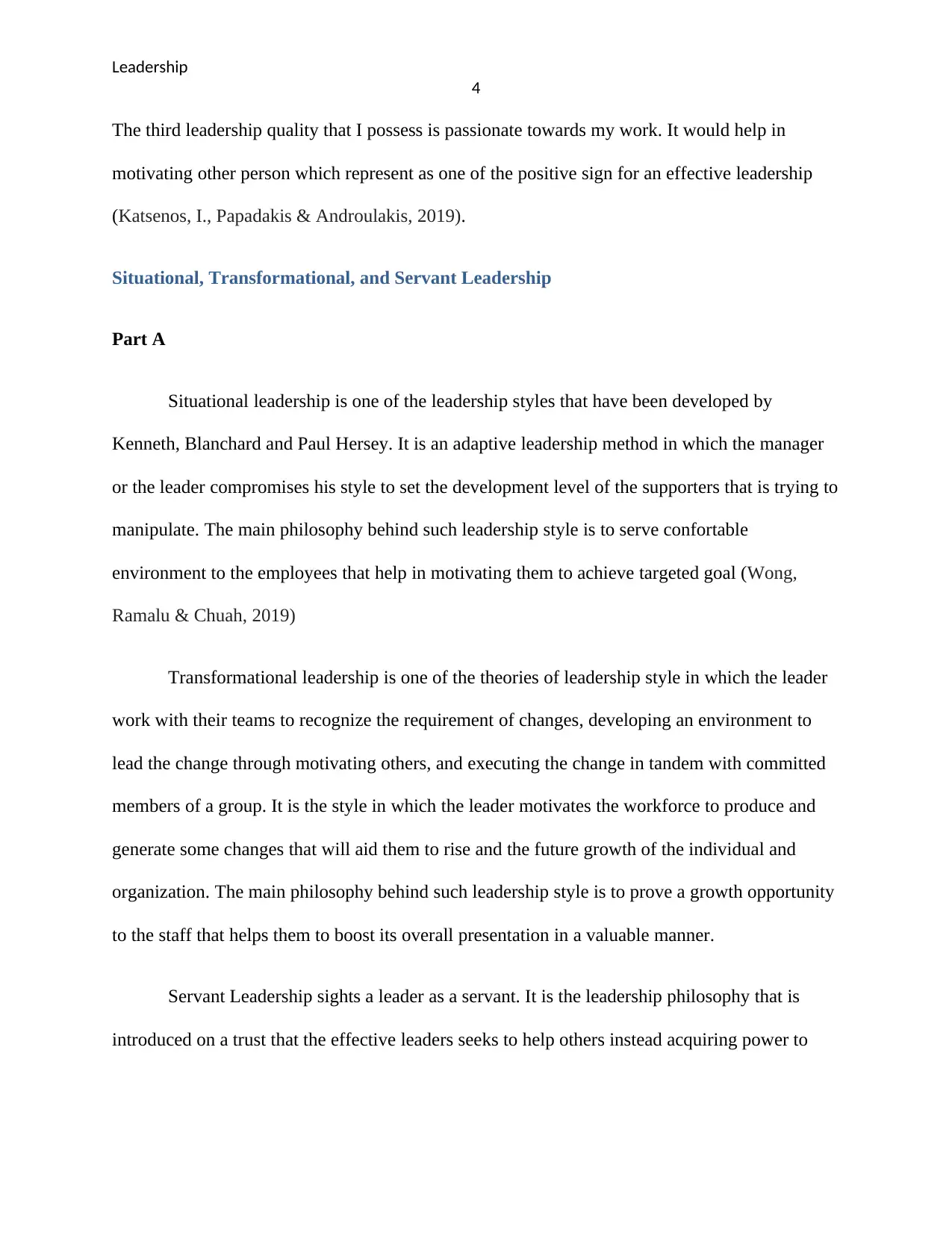
Leadership
4
The third leadership quality that I possess is passionate towards my work. It would help in
motivating other person which represent as one of the positive sign for an effective leadership
(Katsenos, I., Papadakis & Androulakis, 2019).
Situational, Transformational, and Servant Leadership
Part A
Situational leadership is one of the leadership styles that have been developed by
Kenneth, Blanchard and Paul Hersey. It is an adaptive leadership method in which the manager
or the leader compromises his style to set the development level of the supporters that is trying to
manipulate. The main philosophy behind such leadership style is to serve confortable
environment to the employees that help in motivating them to achieve targeted goal (Wong,
Ramalu & Chuah, 2019)
Transformational leadership is one of the theories of leadership style in which the leader
work with their teams to recognize the requirement of changes, developing an environment to
lead the change through motivating others, and executing the change in tandem with committed
members of a group. It is the style in which the leader motivates the workforce to produce and
generate some changes that will aid them to rise and the future growth of the individual and
organization. The main philosophy behind such leadership style is to prove a growth opportunity
to the staff that helps them to boost its overall presentation in a valuable manner.
Servant Leadership sights a leader as a servant. It is the leadership philosophy that is
introduced on a trust that the effective leaders seeks to help others instead acquiring power to
4
The third leadership quality that I possess is passionate towards my work. It would help in
motivating other person which represent as one of the positive sign for an effective leadership
(Katsenos, I., Papadakis & Androulakis, 2019).
Situational, Transformational, and Servant Leadership
Part A
Situational leadership is one of the leadership styles that have been developed by
Kenneth, Blanchard and Paul Hersey. It is an adaptive leadership method in which the manager
or the leader compromises his style to set the development level of the supporters that is trying to
manipulate. The main philosophy behind such leadership style is to serve confortable
environment to the employees that help in motivating them to achieve targeted goal (Wong,
Ramalu & Chuah, 2019)
Transformational leadership is one of the theories of leadership style in which the leader
work with their teams to recognize the requirement of changes, developing an environment to
lead the change through motivating others, and executing the change in tandem with committed
members of a group. It is the style in which the leader motivates the workforce to produce and
generate some changes that will aid them to rise and the future growth of the individual and
organization. The main philosophy behind such leadership style is to prove a growth opportunity
to the staff that helps them to boost its overall presentation in a valuable manner.
Servant Leadership sights a leader as a servant. It is the leadership philosophy that is
introduced on a trust that the effective leaders seeks to help others instead acquiring power to
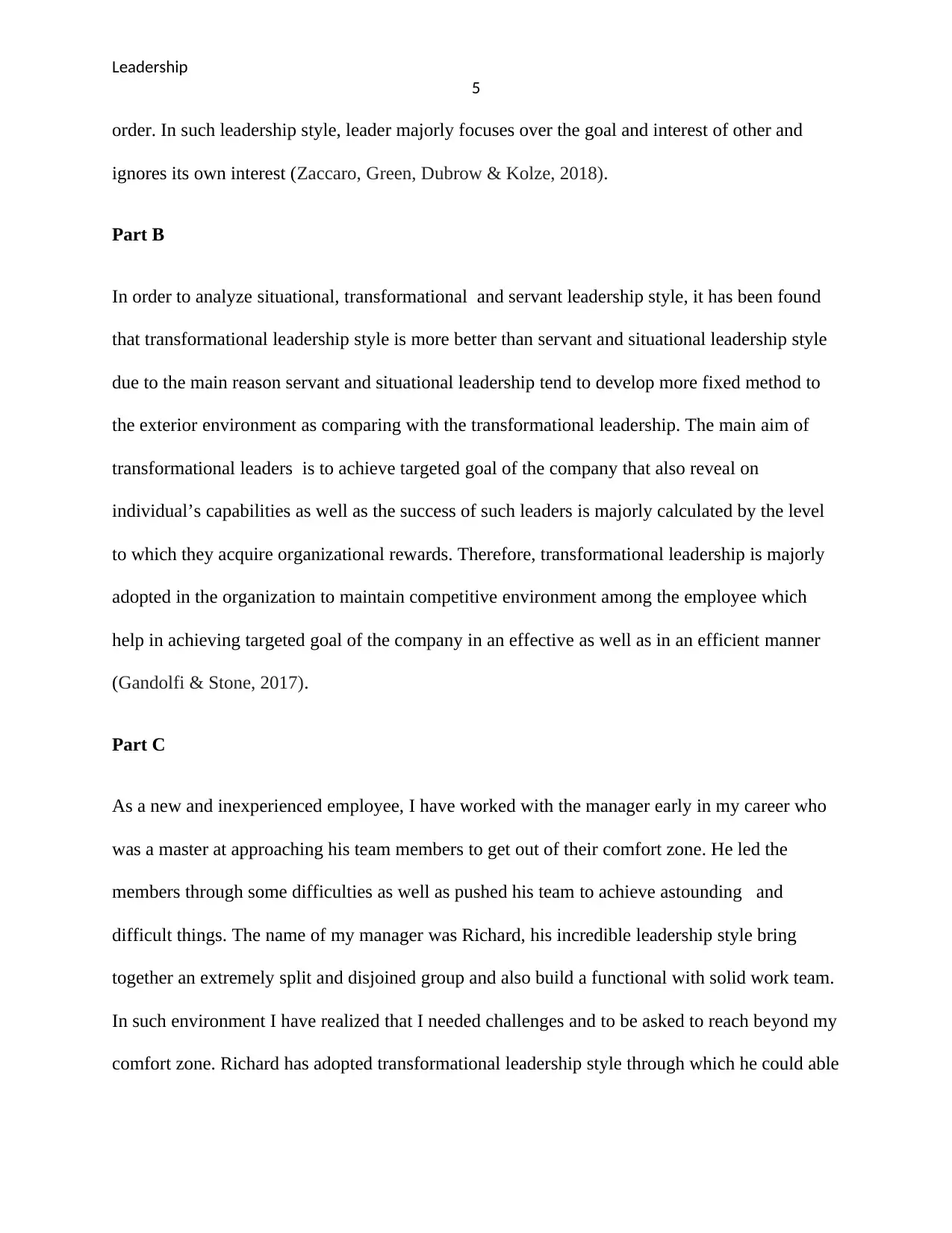
Leadership
5
order. In such leadership style, leader majorly focuses over the goal and interest of other and
ignores its own interest (Zaccaro, Green, Dubrow & Kolze, 2018).
Part B
In order to analyze situational, transformational and servant leadership style, it has been found
that transformational leadership style is more better than servant and situational leadership style
due to the main reason servant and situational leadership tend to develop more fixed method to
the exterior environment as comparing with the transformational leadership. The main aim of
transformational leaders is to achieve targeted goal of the company that also reveal on
individual’s capabilities as well as the success of such leaders is majorly calculated by the level
to which they acquire organizational rewards. Therefore, transformational leadership is majorly
adopted in the organization to maintain competitive environment among the employee which
help in achieving targeted goal of the company in an effective as well as in an efficient manner
(Gandolfi & Stone, 2017).
Part C
As a new and inexperienced employee, I have worked with the manager early in my career who
was a master at approaching his team members to get out of their comfort zone. He led the
members through some difficulties as well as pushed his team to achieve astounding and
difficult things. The name of my manager was Richard, his incredible leadership style bring
together an extremely split and disjoined group and also build a functional with solid work team.
In such environment I have realized that I needed challenges and to be asked to reach beyond my
comfort zone. Richard has adopted transformational leadership style through which he could able
5
order. In such leadership style, leader majorly focuses over the goal and interest of other and
ignores its own interest (Zaccaro, Green, Dubrow & Kolze, 2018).
Part B
In order to analyze situational, transformational and servant leadership style, it has been found
that transformational leadership style is more better than servant and situational leadership style
due to the main reason servant and situational leadership tend to develop more fixed method to
the exterior environment as comparing with the transformational leadership. The main aim of
transformational leaders is to achieve targeted goal of the company that also reveal on
individual’s capabilities as well as the success of such leaders is majorly calculated by the level
to which they acquire organizational rewards. Therefore, transformational leadership is majorly
adopted in the organization to maintain competitive environment among the employee which
help in achieving targeted goal of the company in an effective as well as in an efficient manner
(Gandolfi & Stone, 2017).
Part C
As a new and inexperienced employee, I have worked with the manager early in my career who
was a master at approaching his team members to get out of their comfort zone. He led the
members through some difficulties as well as pushed his team to achieve astounding and
difficult things. The name of my manager was Richard, his incredible leadership style bring
together an extremely split and disjoined group and also build a functional with solid work team.
In such environment I have realized that I needed challenges and to be asked to reach beyond my
comfort zone. Richard has adopted transformational leadership style through which he could able
⊘ This is a preview!⊘
Do you want full access?
Subscribe today to unlock all pages.

Trusted by 1+ million students worldwide
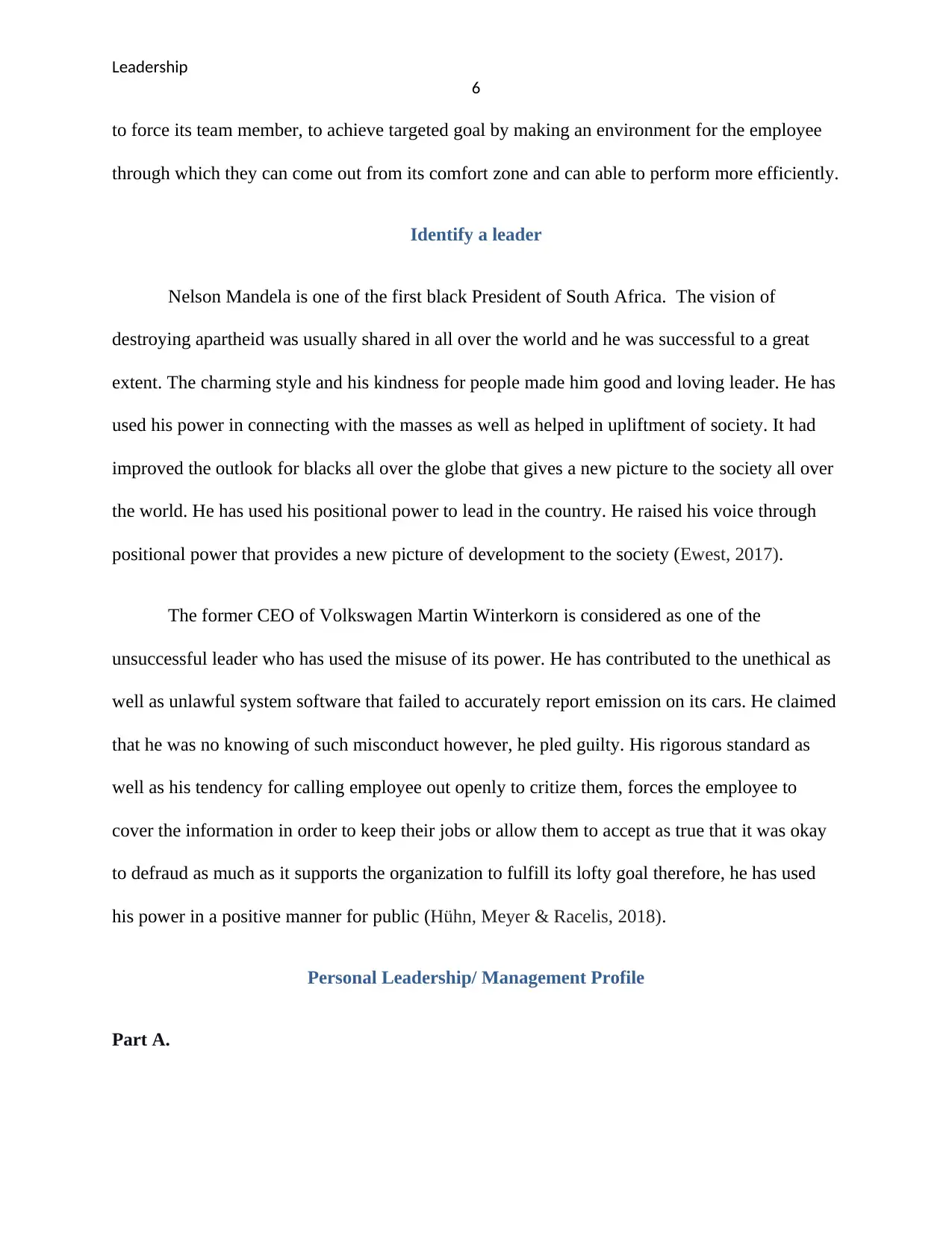
Leadership
6
to force its team member, to achieve targeted goal by making an environment for the employee
through which they can come out from its comfort zone and can able to perform more efficiently.
Identify a leader
Nelson Mandela is one of the first black President of South Africa. The vision of
destroying apartheid was usually shared in all over the world and he was successful to a great
extent. The charming style and his kindness for people made him good and loving leader. He has
used his power in connecting with the masses as well as helped in upliftment of society. It had
improved the outlook for blacks all over the globe that gives a new picture to the society all over
the world. He has used his positional power to lead in the country. He raised his voice through
positional power that provides a new picture of development to the society (Ewest, 2017).
The former CEO of Volkswagen Martin Winterkorn is considered as one of the
unsuccessful leader who has used the misuse of its power. He has contributed to the unethical as
well as unlawful system software that failed to accurately report emission on its cars. He claimed
that he was no knowing of such misconduct however, he pled guilty. His rigorous standard as
well as his tendency for calling employee out openly to critize them, forces the employee to
cover the information in order to keep their jobs or allow them to accept as true that it was okay
to defraud as much as it supports the organization to fulfill its lofty goal therefore, he has used
his power in a positive manner for public (Hühn, Meyer & Racelis, 2018).
Personal Leadership/ Management Profile
Part A.
6
to force its team member, to achieve targeted goal by making an environment for the employee
through which they can come out from its comfort zone and can able to perform more efficiently.
Identify a leader
Nelson Mandela is one of the first black President of South Africa. The vision of
destroying apartheid was usually shared in all over the world and he was successful to a great
extent. The charming style and his kindness for people made him good and loving leader. He has
used his power in connecting with the masses as well as helped in upliftment of society. It had
improved the outlook for blacks all over the globe that gives a new picture to the society all over
the world. He has used his positional power to lead in the country. He raised his voice through
positional power that provides a new picture of development to the society (Ewest, 2017).
The former CEO of Volkswagen Martin Winterkorn is considered as one of the
unsuccessful leader who has used the misuse of its power. He has contributed to the unethical as
well as unlawful system software that failed to accurately report emission on its cars. He claimed
that he was no knowing of such misconduct however, he pled guilty. His rigorous standard as
well as his tendency for calling employee out openly to critize them, forces the employee to
cover the information in order to keep their jobs or allow them to accept as true that it was okay
to defraud as much as it supports the organization to fulfill its lofty goal therefore, he has used
his power in a positive manner for public (Hühn, Meyer & Racelis, 2018).
Personal Leadership/ Management Profile
Part A.
Paraphrase This Document
Need a fresh take? Get an instant paraphrase of this document with our AI Paraphraser
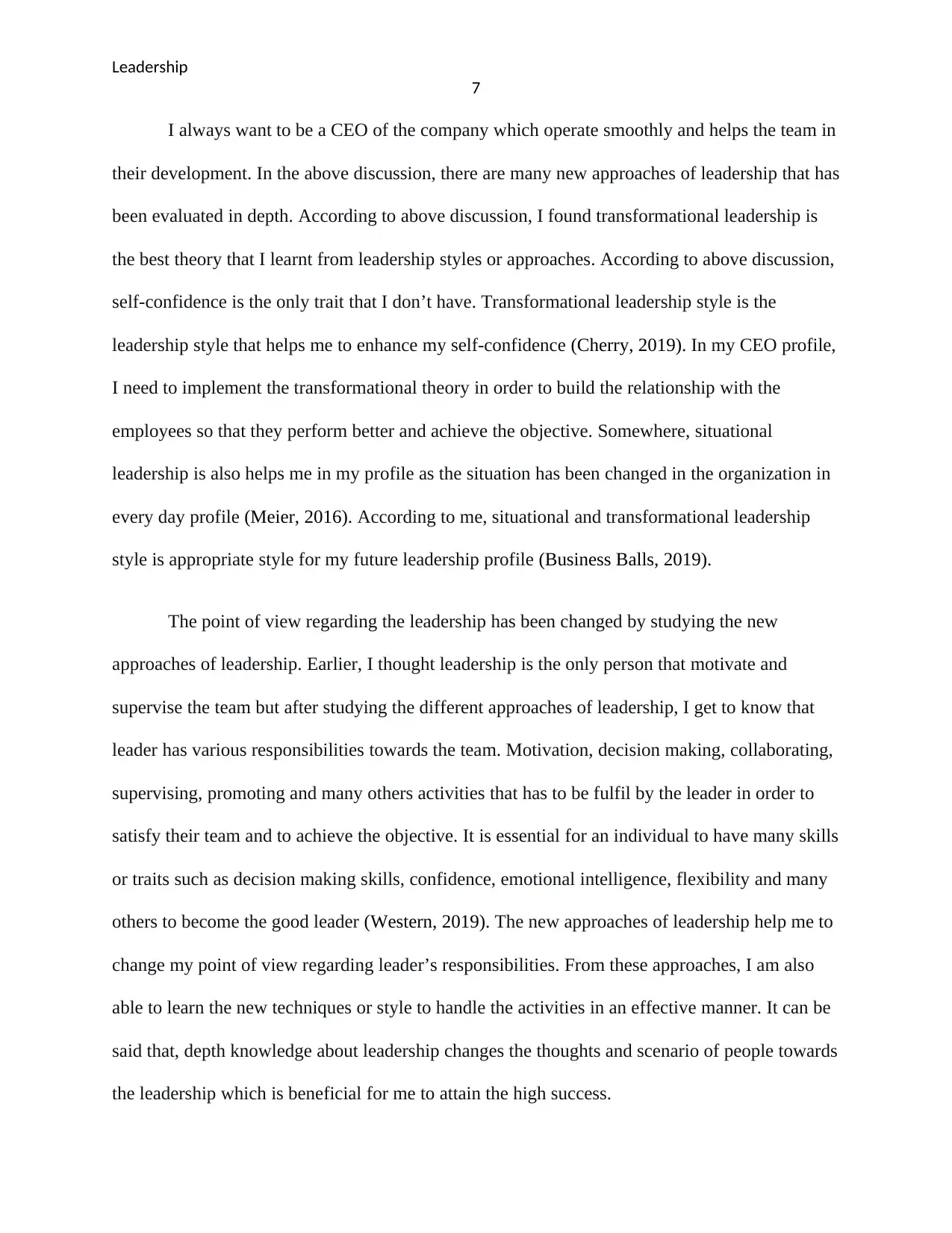
Leadership
7
I always want to be a CEO of the company which operate smoothly and helps the team in
their development. In the above discussion, there are many new approaches of leadership that has
been evaluated in depth. According to above discussion, I found transformational leadership is
the best theory that I learnt from leadership styles or approaches. According to above discussion,
self-confidence is the only trait that I don’t have. Transformational leadership style is the
leadership style that helps me to enhance my self-confidence (Cherry, 2019). In my CEO profile,
I need to implement the transformational theory in order to build the relationship with the
employees so that they perform better and achieve the objective. Somewhere, situational
leadership is also helps me in my profile as the situation has been changed in the organization in
every day profile (Meier, 2016). According to me, situational and transformational leadership
style is appropriate style for my future leadership profile (Business Balls, 2019).
The point of view regarding the leadership has been changed by studying the new
approaches of leadership. Earlier, I thought leadership is the only person that motivate and
supervise the team but after studying the different approaches of leadership, I get to know that
leader has various responsibilities towards the team. Motivation, decision making, collaborating,
supervising, promoting and many others activities that has to be fulfil by the leader in order to
satisfy their team and to achieve the objective. It is essential for an individual to have many skills
or traits such as decision making skills, confidence, emotional intelligence, flexibility and many
others to become the good leader (Western, 2019). The new approaches of leadership help me to
change my point of view regarding leader’s responsibilities. From these approaches, I am also
able to learn the new techniques or style to handle the activities in an effective manner. It can be
said that, depth knowledge about leadership changes the thoughts and scenario of people towards
the leadership which is beneficial for me to attain the high success.
7
I always want to be a CEO of the company which operate smoothly and helps the team in
their development. In the above discussion, there are many new approaches of leadership that has
been evaluated in depth. According to above discussion, I found transformational leadership is
the best theory that I learnt from leadership styles or approaches. According to above discussion,
self-confidence is the only trait that I don’t have. Transformational leadership style is the
leadership style that helps me to enhance my self-confidence (Cherry, 2019). In my CEO profile,
I need to implement the transformational theory in order to build the relationship with the
employees so that they perform better and achieve the objective. Somewhere, situational
leadership is also helps me in my profile as the situation has been changed in the organization in
every day profile (Meier, 2016). According to me, situational and transformational leadership
style is appropriate style for my future leadership profile (Business Balls, 2019).
The point of view regarding the leadership has been changed by studying the new
approaches of leadership. Earlier, I thought leadership is the only person that motivate and
supervise the team but after studying the different approaches of leadership, I get to know that
leader has various responsibilities towards the team. Motivation, decision making, collaborating,
supervising, promoting and many others activities that has to be fulfil by the leader in order to
satisfy their team and to achieve the objective. It is essential for an individual to have many skills
or traits such as decision making skills, confidence, emotional intelligence, flexibility and many
others to become the good leader (Western, 2019). The new approaches of leadership help me to
change my point of view regarding leader’s responsibilities. From these approaches, I am also
able to learn the new techniques or style to handle the activities in an effective manner. It can be
said that, depth knowledge about leadership changes the thoughts and scenario of people towards
the leadership which is beneficial for me to attain the high success.
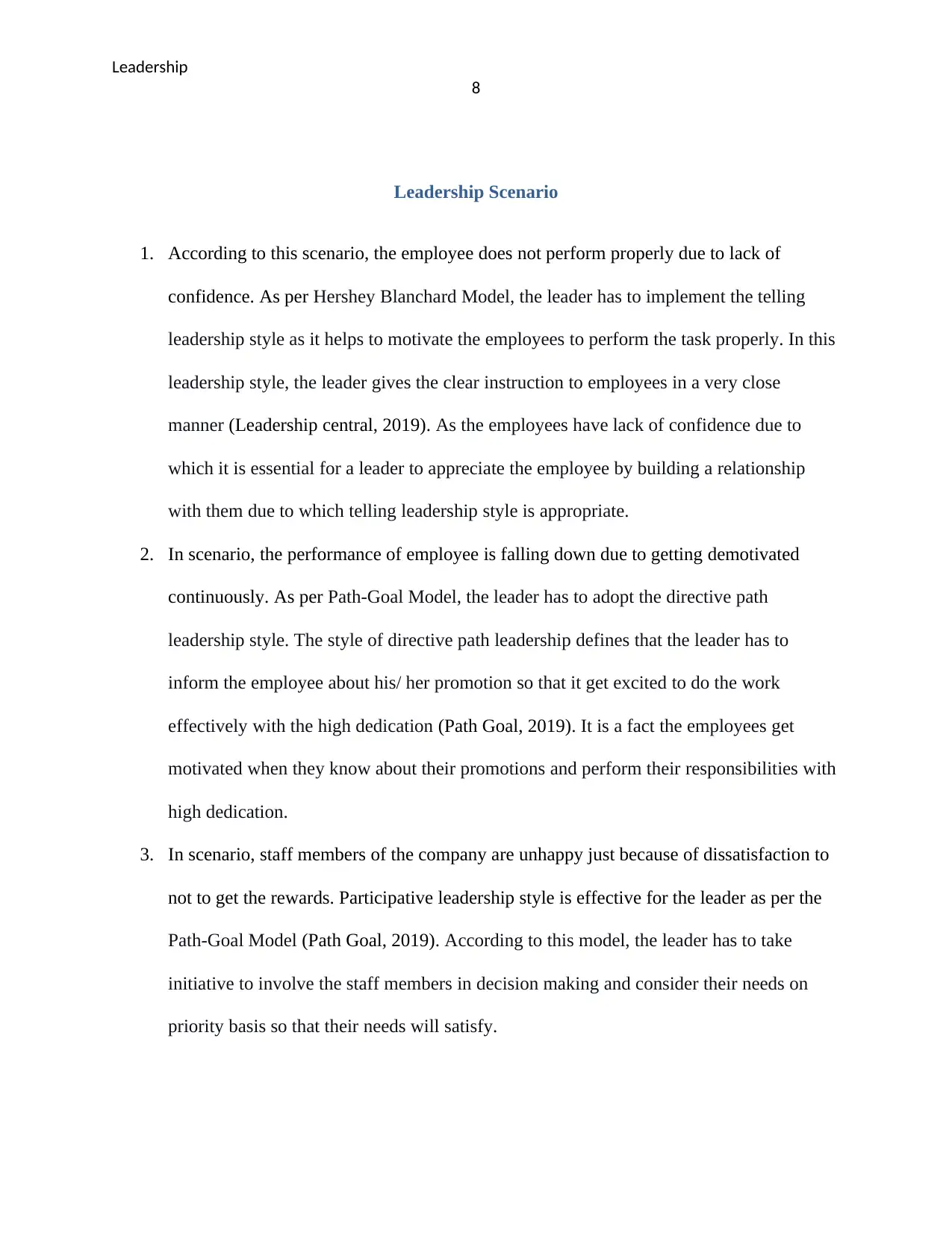
Leadership
8
Leadership Scenario
1. According to this scenario, the employee does not perform properly due to lack of
confidence. As per Hershey Blanchard Model, the leader has to implement the telling
leadership style as it helps to motivate the employees to perform the task properly. In this
leadership style, the leader gives the clear instruction to employees in a very close
manner (Leadership central, 2019). As the employees have lack of confidence due to
which it is essential for a leader to appreciate the employee by building a relationship
with them due to which telling leadership style is appropriate.
2. In scenario, the performance of employee is falling down due to getting demotivated
continuously. As per Path-Goal Model, the leader has to adopt the directive path
leadership style. The style of directive path leadership defines that the leader has to
inform the employee about his/ her promotion so that it get excited to do the work
effectively with the high dedication (Path Goal, 2019). It is a fact the employees get
motivated when they know about their promotions and perform their responsibilities with
high dedication.
3. In scenario, staff members of the company are unhappy just because of dissatisfaction to
not to get the rewards. Participative leadership style is effective for the leader as per the
Path-Goal Model (Path Goal, 2019). According to this model, the leader has to take
initiative to involve the staff members in decision making and consider their needs on
priority basis so that their needs will satisfy.
8
Leadership Scenario
1. According to this scenario, the employee does not perform properly due to lack of
confidence. As per Hershey Blanchard Model, the leader has to implement the telling
leadership style as it helps to motivate the employees to perform the task properly. In this
leadership style, the leader gives the clear instruction to employees in a very close
manner (Leadership central, 2019). As the employees have lack of confidence due to
which it is essential for a leader to appreciate the employee by building a relationship
with them due to which telling leadership style is appropriate.
2. In scenario, the performance of employee is falling down due to getting demotivated
continuously. As per Path-Goal Model, the leader has to adopt the directive path
leadership style. The style of directive path leadership defines that the leader has to
inform the employee about his/ her promotion so that it get excited to do the work
effectively with the high dedication (Path Goal, 2019). It is a fact the employees get
motivated when they know about their promotions and perform their responsibilities with
high dedication.
3. In scenario, staff members of the company are unhappy just because of dissatisfaction to
not to get the rewards. Participative leadership style is effective for the leader as per the
Path-Goal Model (Path Goal, 2019). According to this model, the leader has to take
initiative to involve the staff members in decision making and consider their needs on
priority basis so that their needs will satisfy.
⊘ This is a preview!⊘
Do you want full access?
Subscribe today to unlock all pages.

Trusted by 1+ million students worldwide
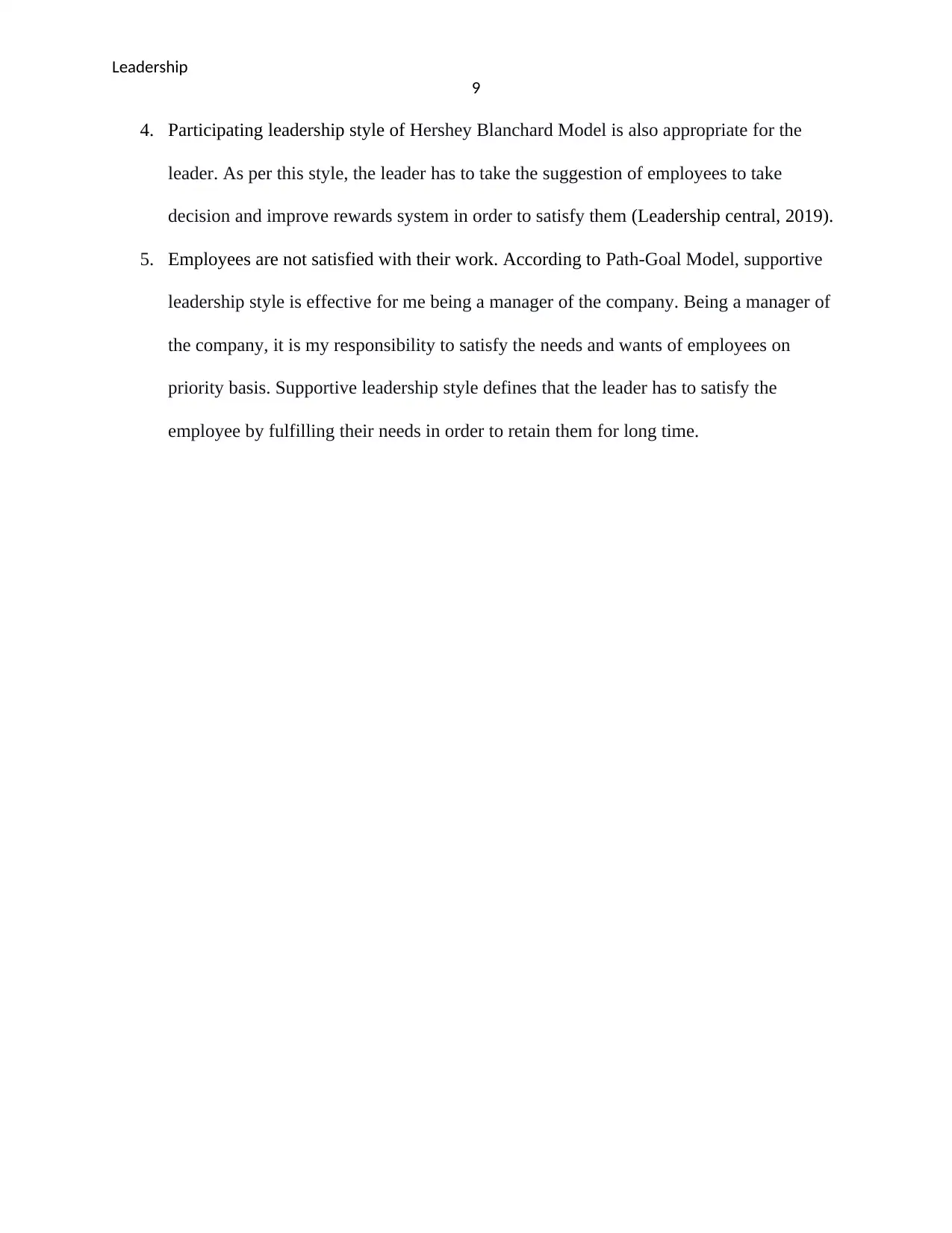
Leadership
9
4. Participating leadership style of Hershey Blanchard Model is also appropriate for the
leader. As per this style, the leader has to take the suggestion of employees to take
decision and improve rewards system in order to satisfy them (Leadership central, 2019).
5. Employees are not satisfied with their work. According to Path-Goal Model, supportive
leadership style is effective for me being a manager of the company. Being a manager of
the company, it is my responsibility to satisfy the needs and wants of employees on
priority basis. Supportive leadership style defines that the leader has to satisfy the
employee by fulfilling their needs in order to retain them for long time.
9
4. Participating leadership style of Hershey Blanchard Model is also appropriate for the
leader. As per this style, the leader has to take the suggestion of employees to take
decision and improve rewards system in order to satisfy them (Leadership central, 2019).
5. Employees are not satisfied with their work. According to Path-Goal Model, supportive
leadership style is effective for me being a manager of the company. Being a manager of
the company, it is my responsibility to satisfy the needs and wants of employees on
priority basis. Supportive leadership style defines that the leader has to satisfy the
employee by fulfilling their needs in order to retain them for long time.
Paraphrase This Document
Need a fresh take? Get an instant paraphrase of this document with our AI Paraphraser
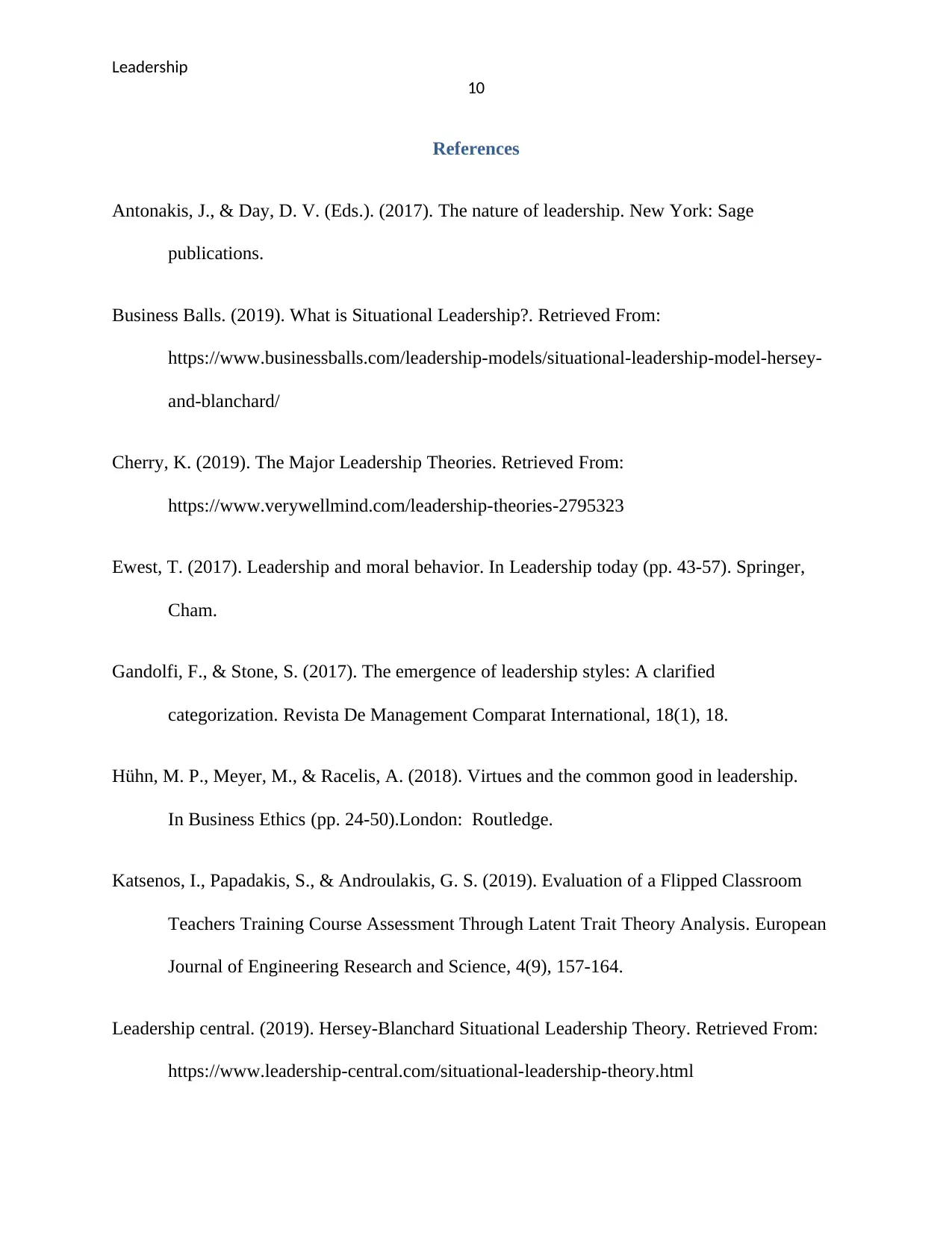
Leadership
10
References
Antonakis, J., & Day, D. V. (Eds.). (2017). The nature of leadership. New York: Sage
publications.
Business Balls. (2019). What is Situational Leadership?. Retrieved From:
https://www.businessballs.com/leadership-models/situational-leadership-model-hersey-
and-blanchard/
Cherry, K. (2019). The Major Leadership Theories. Retrieved From:
https://www.verywellmind.com/leadership-theories-2795323
Ewest, T. (2017). Leadership and moral behavior. In Leadership today (pp. 43-57). Springer,
Cham.
Gandolfi, F., & Stone, S. (2017). The emergence of leadership styles: A clarified
categorization. Revista De Management Comparat International, 18(1), 18.
Hühn, M. P., Meyer, M., & Racelis, A. (2018). Virtues and the common good in leadership.
In Business Ethics (pp. 24-50).London: Routledge.
Katsenos, I., Papadakis, S., & Androulakis, G. S. (2019). Evaluation of a Flipped Classroom
Teachers Training Course Assessment Through Latent Trait Theory Analysis. European
Journal of Engineering Research and Science, 4(9), 157-164.
Leadership central. (2019). Hersey-Blanchard Situational Leadership Theory. Retrieved From:
https://www.leadership-central.com/situational-leadership-theory.html
10
References
Antonakis, J., & Day, D. V. (Eds.). (2017). The nature of leadership. New York: Sage
publications.
Business Balls. (2019). What is Situational Leadership?. Retrieved From:
https://www.businessballs.com/leadership-models/situational-leadership-model-hersey-
and-blanchard/
Cherry, K. (2019). The Major Leadership Theories. Retrieved From:
https://www.verywellmind.com/leadership-theories-2795323
Ewest, T. (2017). Leadership and moral behavior. In Leadership today (pp. 43-57). Springer,
Cham.
Gandolfi, F., & Stone, S. (2017). The emergence of leadership styles: A clarified
categorization. Revista De Management Comparat International, 18(1), 18.
Hühn, M. P., Meyer, M., & Racelis, A. (2018). Virtues and the common good in leadership.
In Business Ethics (pp. 24-50).London: Routledge.
Katsenos, I., Papadakis, S., & Androulakis, G. S. (2019). Evaluation of a Flipped Classroom
Teachers Training Course Assessment Through Latent Trait Theory Analysis. European
Journal of Engineering Research and Science, 4(9), 157-164.
Leadership central. (2019). Hersey-Blanchard Situational Leadership Theory. Retrieved From:
https://www.leadership-central.com/situational-leadership-theory.html
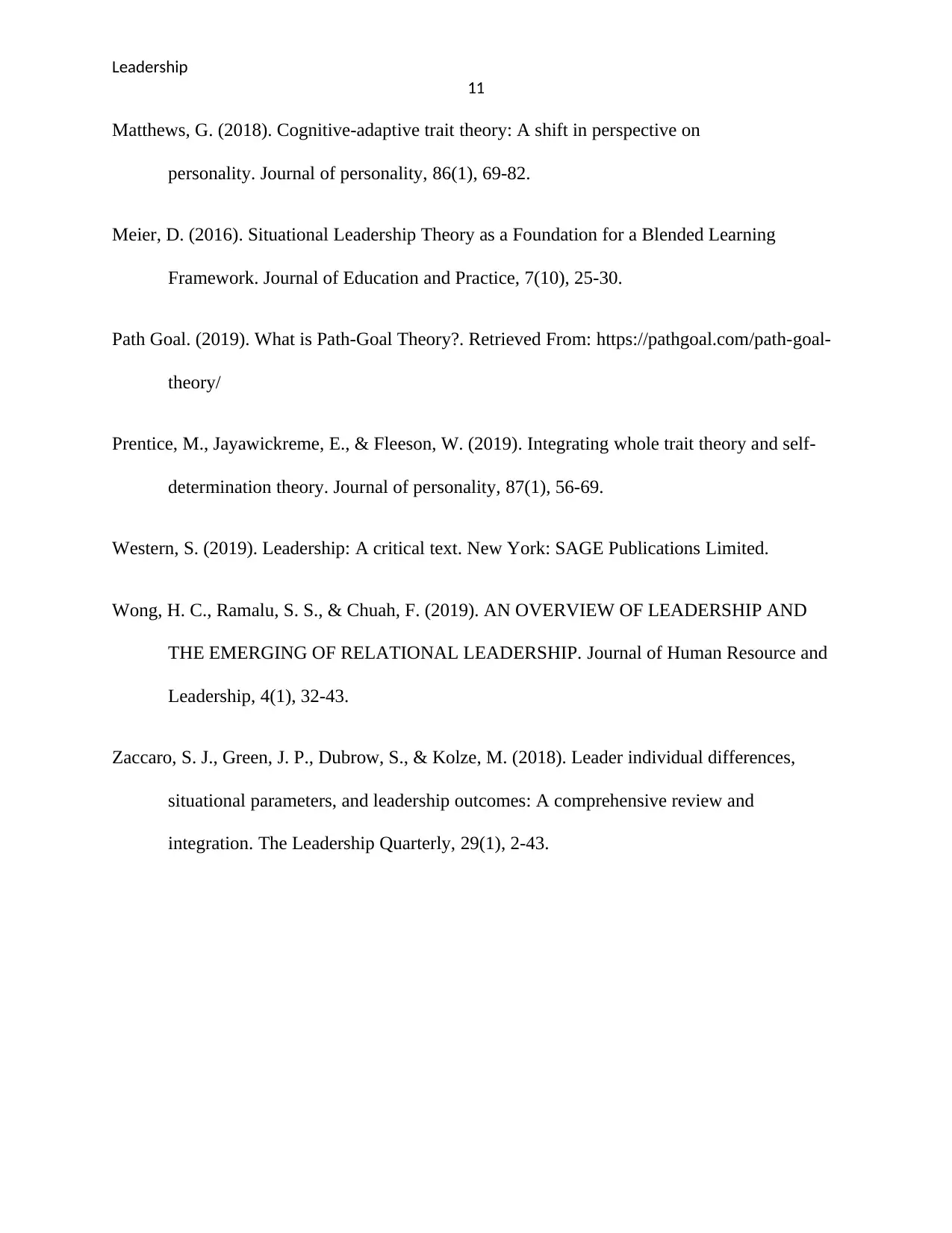
Leadership
11
Matthews, G. (2018). Cognitive‐adaptive trait theory: A shift in perspective on
personality. Journal of personality, 86(1), 69-82.
Meier, D. (2016). Situational Leadership Theory as a Foundation for a Blended Learning
Framework. Journal of Education and Practice, 7(10), 25-30.
Path Goal. (2019). What is Path-Goal Theory?. Retrieved From: https://pathgoal.com/path-goal-
theory/
Prentice, M., Jayawickreme, E., & Fleeson, W. (2019). Integrating whole trait theory and self‐
determination theory. Journal of personality, 87(1), 56-69.
Western, S. (2019). Leadership: A critical text. New York: SAGE Publications Limited.
Wong, H. C., Ramalu, S. S., & Chuah, F. (2019). AN OVERVIEW OF LEADERSHIP AND
THE EMERGING OF RELATIONAL LEADERSHIP. Journal of Human Resource and
Leadership, 4(1), 32-43.
Zaccaro, S. J., Green, J. P., Dubrow, S., & Kolze, M. (2018). Leader individual differences,
situational parameters, and leadership outcomes: A comprehensive review and
integration. The Leadership Quarterly, 29(1), 2-43.
11
Matthews, G. (2018). Cognitive‐adaptive trait theory: A shift in perspective on
personality. Journal of personality, 86(1), 69-82.
Meier, D. (2016). Situational Leadership Theory as a Foundation for a Blended Learning
Framework. Journal of Education and Practice, 7(10), 25-30.
Path Goal. (2019). What is Path-Goal Theory?. Retrieved From: https://pathgoal.com/path-goal-
theory/
Prentice, M., Jayawickreme, E., & Fleeson, W. (2019). Integrating whole trait theory and self‐
determination theory. Journal of personality, 87(1), 56-69.
Western, S. (2019). Leadership: A critical text. New York: SAGE Publications Limited.
Wong, H. C., Ramalu, S. S., & Chuah, F. (2019). AN OVERVIEW OF LEADERSHIP AND
THE EMERGING OF RELATIONAL LEADERSHIP. Journal of Human Resource and
Leadership, 4(1), 32-43.
Zaccaro, S. J., Green, J. P., Dubrow, S., & Kolze, M. (2018). Leader individual differences,
situational parameters, and leadership outcomes: A comprehensive review and
integration. The Leadership Quarterly, 29(1), 2-43.
⊘ This is a preview!⊘
Do you want full access?
Subscribe today to unlock all pages.

Trusted by 1+ million students worldwide
1 out of 12
Related Documents
Your All-in-One AI-Powered Toolkit for Academic Success.
+13062052269
info@desklib.com
Available 24*7 on WhatsApp / Email
![[object Object]](/_next/static/media/star-bottom.7253800d.svg)
Unlock your academic potential
Copyright © 2020–2025 A2Z Services. All Rights Reserved. Developed and managed by ZUCOL.




